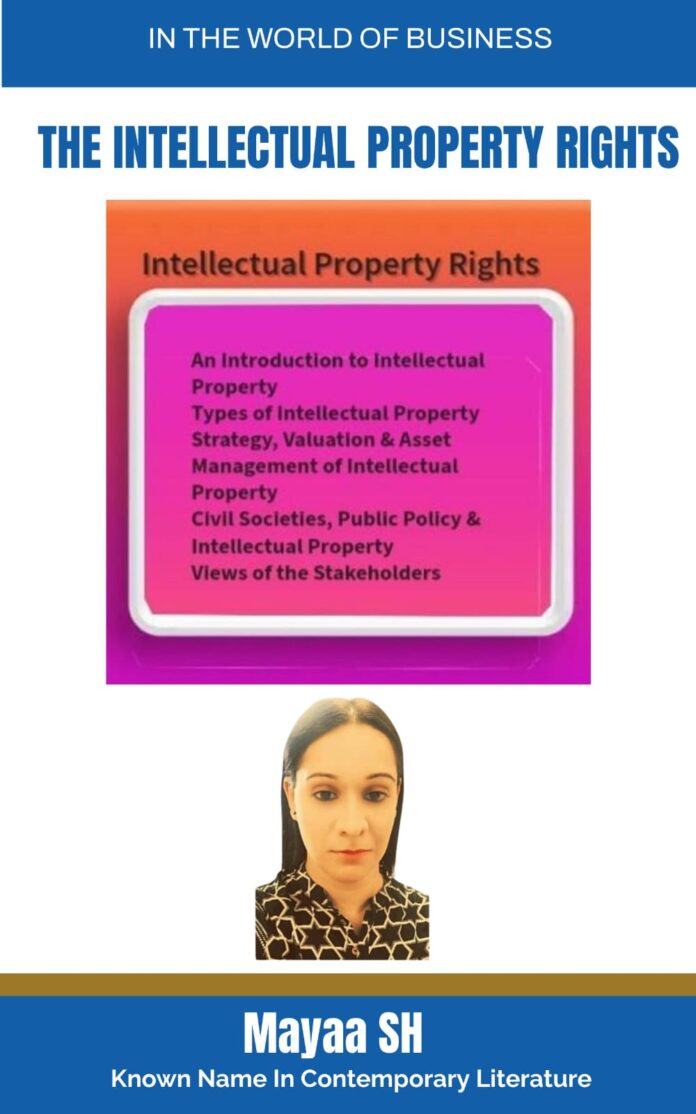Women Empowerment Culturist, Essayist, Thinker, Social and Legal Activist on advisories on family law in India, Evolutionary Developmental Feminist, Social Activist and Campaigner for Women’s Rights, Multiple State, National Award Winner and Internationally acclaimed Multiple World Record Holder, Renowned name in Contemporary Literature Authoress, Suicide Prevention Expert Dr Mayaa SH shares her valuable insights.
How are the Intellectual Property Rights defined?
The Intellectual Property Rights are basically those rights which allows the owner to take the benefits of his inventions, creative works, names, and symbols by creating his monopoly over the products which have been developed by the owner itself. These Rights can also stop others from using that symbol, artistic work or doing that particular work. It provides right to protection to the owner from any artistic and other literary products. These rights prohibit the other persons from using the intellectual property of an individual for commercial use without the permission of the owner. The major Intellectual property rights includes trademark, patents, copyrights, geographical indication, designs etc.
What are the types of Intellectual Property Rights?
Intellectual property is a broad categorical description of a set of intangible assets that are owned by a company or individual. It’s legally protected from outside use or implementation without consent. An intangible asset is a non-physical asset. The concept of intellectual property relates to the fact that certain products of human intellect should be afforded the same protective rights that apply to physical property, called tangible assets. Most developed economies have legal measures in place to protect both forms of property. The seven types of Intellectual Property Rights (IPR) include patents, trademarks, copyrights, trade secrets, industrial designs, geographical indications, and plant variety rights. Each type of IPR provides legal protection for different forms of intellectual creations and innovations:
(1) Patents:
A patent is a property right for an investor that’s typically granted by a government agency such as the U.S. Patent and Trademark Office. The patent allows the inventor exclusive rights to the invention, which could be a design, process, improvement, or physical invention such as a machine. Technology and software companies often have patents for their designs. The patent for the personal computer was filed in 1980 by Steve Jobs and three other colleagues at Apple (AAPL).
(2) Copyrights :
Copyrights provide authors and creators of original material the exclusive right to use, copy, or duplicate their material. Authors of books have their works copyrighted as do musical artists. A copyright also states that the original creators can grant anyone authorization through a licensing agreement to use the work.
(3) Trademarks:
A trademark is a symbol, phrase, or insignia that’s recognizable and represents a product that legally separates it from other products. A trademark is exclusively assigned to a company. It owns the trademark so no others may use or copy it.A trademark is often associated with a company’s brand. The logo and brand name of Coca-Cola is owned by the Coca-Cola Company (KO).
(4) Franchises:
A franchise is a license purchased by a company, individual, or a party called the franchisee. It allows them to use the franchisor’s name, trademark, proprietary knowledge, and processes.
(5) Trade Secrets:
A trade secret is a company’s process or practice that isn’t public information and provides an economic benefit or advantage to the company or holder of the trade secret. Trade secrets must be actively protected by the company and are typically the result of a company’s research and development (R&D). This is why some employers require the signing of non-disclosure agreements (NDAs).
(6) Digital Assets:
Digital assets are also increasingly recognized as intellectual property. These would include proprietary software code or algorithms and online digital content.
What is an Intellectual Property Strategy?
Intellectual Property (IP) strategy is a systematic approach that organizations and individuals adopt to manage and leverage their intellectual property assets effectively. Inventions, literary and artistic works, designs, symbols, names, and pictures utilized in commerce are all examples of intellectual property. Developing a well-defined IP strategy is crucial for businesses and individuals to protect their innovations, establish a competitive advantage, and maximize the value of their intellectual property assets. Few Critical Components of an IP Strategy include:
(1) Identifying Intellectual Property Assets:
The first step in developing an IP strategy is identifying and cataloguing all the intellectual property assets within an organization or individual’s portfolio. These assets can include: patents, trademarks, copyrights, trade secrets, industrial designs. A comprehensive inventory helps in understanding the scope and value of these assets.
(2) Setting Clear Goals and Objectives:
Defining the goals and objectives of an IP strategy is essential. Organizations might aim to protect their inventions, establish brand recognition through trademarks, prevent unauthorized use of their creative works, or use their IP to generate revenue through licensing agreements. Clarity about goals guides decision-making throughout the IP lifecycle.
(3) IP Creation and Documentation:
Establishing robust documentation procedures is essential to ensure a strong foundation for IP protection. Properly documenting the creation and development of inventions, designs, and creative works can play a crucial role in proving ownership and maintaining the validity of IP rights.
(4) IP Protection:
Protecting intellectual property involves obtaining the appropriate legal protections. The strategy could encompass evaluating the jurisdictions, analyzing the security cost-benefit, and determining the timeline for filing applications. Enforcement and Defense An effective IP strategy should address how to enforce IP rights if infringements occur. Preparing to defend IP rights ensures that the effort put into obtaining protections is well-spent.
(5) IP Commercialization and Monetization:
Monetizing intellectual property can take various forms, such as licensing IP to other parties, selling IP assets, or using IP to create revenue-generating products and services. A strategy should outline how and when to license, negotiate terms, and ensure the chosen approach aligns with the overall business goals.
(6) Monitoring and Maintenance:
IP rights require ongoing attention. Critical components are monitoring the landscape for potential infringements, renewing registrations, and adapting the strategy as the business and IP landscape evolves. Neglecting maintenance can result in a loss of rights.
(7) Training and Education:
Educating employees, collaborators, and stakeholders about the importance of IP and their roles in protecting it is often overlooked but essential. Proper training can help prevent inadvertent breaches of IP rights and foster a culture of IP awareness. Global Considerations
For international organizations, a well-rounded IP strategy should account for different legal frameworks, cultural nuances, and market conditions in various jurisdictions. Tailoring the plan to the individual demands of each location can maximize protective and enforcement activities.
What is the Role of Civil Society, Public Policy and Intellectual Property Rights?
Public awareness and advocacy are instrumental in maintaining this delicate balance. Educating the public about the ethical implications of intellectual property decisions empowers individuals to advocate for a balanced approach. Civil society engagement ensures that diverse perspectives are considered in shaping intellectual property policies, strengthening the democratic process. Achieving equilibrium between IPR and human rights involves a combination of legal frameworks, responsible innovation practices, inclusive strategies, international collaboration, public-private partnerships, and public awareness. A holistic and collaborative approach is essential to navigate the complexities of the intersection between intellectual property rights and human rights in the pursuit of a fair and ethical innovation landscape.
Relevant Case Laws:
In the Novartis v Union of India case (AIR 2013 SC 1311), the Supreme Court of India prioritised the significance of lifesaving drugs over patent rights. Novartis Pharmaceutical Company contested the constitutionality of Section 3(d) of the Patent Act, 1970, seeking a patent for a cancer drug involving the substance imatinib mesylate. The court ruled that imatinib mesylate did not meet the criteria of Section 3(d) and, therefore, was not patentable, emphasizing that the merediscovery of a new form of a known substance does not qualify as innovation. The detailed interpretation affirmed the constitutional validity of Section 3(d), marking a paradigm shift in the approach towards patents and lifesaving drugs. The judgment underscored the global unacceptability of denying access to crucial medicines to millions due to pharmaceutical companies’ monopolies.
In navigating the delicate intersection between Intellectual Property Rights (IPR) and human rights, the text underscores the imperative to strike a harmonious balance. Analyzing pivotal case laws, such as Novartis v Union of India and Bayer Corporation v Union of India, it accentuates the growing recognition ofh public interest over exclusive patent rights, particularly in the realm of essential medicines. The ethical dilemma arising from access restrictions and technological disparities demands a multifaceted approach. Proposing solutions, the text advocates for flexible legal frameworks, responsible innovation practices, and inclusive strategies. It stresses the pivotal role of international collaboration, exemplified by experiences in countries like South Africa and Thailand, in leveraging TRIPS flexibilities for social welfare. The conclusion emphasizes the need for public-private partnerships and heightened public awareness to maintain a delicate equilibrium.
What is the view of Stakeholders on the Intellectual Property Rights?
IP can be infringed, misused, or contested by various stakeholders, such as competitors, customers, suppliers, employees, regulators, or the public. To protect your brand’s IP and reputation, you need to identify and manage these stakeholders effectively. Some of the common types of IP stakeholders are:
(1) Inventors: Inventors are the individuals who create or contribute to the creation of IP, such as patents, designs, or trade secrets. Inventors are often the original source of the IP, and they may have a strong personal attachment or pride in their work. Inventors may also have a legal right to be named as inventors in the IP documents, and to receive a fair share of the benefits or rewards from the IP. Inventors may seek recognition, protection, or compensation for their IP, and they may also want to have a say in how the IP is used or licensed. For example, an inventor may prefer to license their patent to a company that shares their vision or values, rather than to a competitor or a generic manufacturer. Inventors may also want to retain some control or access to the IP, such as the right to use it for their own research or teaching purposes.
(2) Owners: Owners are the individuals or entities who own or have the legal rights to the IP, such as the patent holders, trademark registrants, or copyright holders. Owners may acquire the IP from the inventors, either by assignment, employment, or contract. Owners may also create or register the IP themselves, such as by filing a patent application or registering a trademark. Owners are responsible for managing and maintaining the IP, such as by paying fees, renewing registrations, or enforcing the IP against infringement. Owners may also decide how to exploit or commercialize the IP, such as by selling, licensing, or donating it. Owners may seek to maximize the value or impact of their IP, and they may have different strategies or preferences for doing so. For example, an owner may choose to license their IP exclusively to one partner, or to license it non-exclusively to multiple partners. Owners may also choose to keep their IP secret, or to disclose it to the public.
(3) Users: Users are the individuals or entities who use or benefit from the IP, such as the licensees, customers, or consumers of the IP. Users may access the IP through various means, such as by purchasing, licensing, or borrowing it. Users may also create or generate new IP based on the existing IP, such as by improving, modifying, or adapting it. Users may seek to obtain or use the IP for various purposes, such as for research, development, innovation, education, or entertainment. Users may also seek to respect or comply with the IP rights and obligations, such as by paying royalties, acknowledging sources, or obtaining permissions. Users may have different needs or expectations from the IP, and they may also provide feedback or suggestions to the inventors or owners of the IP. For example, a user may request a customized or tailored version of the IP, or a user may report a defect or a problem with the IP.
(4) Beneficiaries: Beneficiaries are the individuals or groups who are affected by or have an interest in the IP, such as the society, the environment, or the public. Beneficiaries may not directly create, own, or use the IP, but they may have a stake or influence in the IP, such as by providing funding, support, or guidance to the IP stakeholders. Beneficiaries may also have a moral or ethical concern or responsibility for the IP, such as by ensuring that the IP is used for good or beneficial purposes, or that the IP does not cause harm or damage to others. Beneficiaries may seek to promote or protect the IP, or to balance or regulate the IP, depending on their values or interests. For example, a beneficiary may advocate for the IP to be accessible or affordable to the public, or a beneficiary may oppose or restrict the IP if it poses a threat or a risk to the environment.
Key Takeaways here are:
(1) Intellectual property is an umbrella term for a set of intangible assets or assets that aren’t physical in nature.
(2) Intellectual property is owned and legally protected from outside use or implementation by a person or company without consent.
(3) It can consist of many types of assets, including trademarks, patents, and copyrights.
(4) Intellectual property infringement occurs when a third party engages in the unauthorized use of the asset.
(5) Legal protections for most intellectual property expire after some time but they can last forever for others.





















